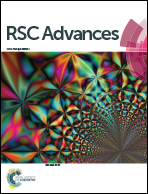Diketo acids and their amino acid/dipeptidic analogues as promising scaffolds for the development of bacterial methionine aminopeptidase inhibitors
Abstract
Using diketoesters as the template, various derivatives were designed and the selected compounds were synthesized as bacterial methionine aminopeptidase (MetAP) inhibitors. The results of in vitro antibacterial screening revealed fifteen compounds (1a–c, 1e–h, 1j, 1l, 2a–c, 3d, 5c and 5e) as potent against different bacterial strains. By using the MTT assay on human cell line (HepG2), the viability of cell proliferation was evaluated and nine compounds (1c, 1e, 1j, 1l, 2a,b, 3d, 5c and 5e) showed no cytotoxic effect at the concentration range of 50–450 μg ml−1. In the biochemical evaluation against methionine aminopeptidase (MetAPs) from Streptococcus pneumonia (SpMetAP), Mycobacterium tuberculosis (MtMetAP), Enterococcus faecalis (EfMetAP) and human (HsMetAP), compounds displayed differential behaviour against these four enzymes. Moreover, compound 1g showed 84% inhibition of SpMetAP, while compound 3d selectively inhibited MtMetAP with 79% inhibition and little effect on HsMetAP at 100 μM concentration. At the same concentration, compound 5e exhibited 87% and 85% inhibition of EfMetAP and SpMetAP, respectively. Understanding the mode of binding through modeling at the active site provided the structural basis for the possible mode of inhibition. Together, these data will be useful for further development of diketo acid based inhibitors with improved potency and selectivity.


 Please wait while we load your content...
Please wait while we load your content...